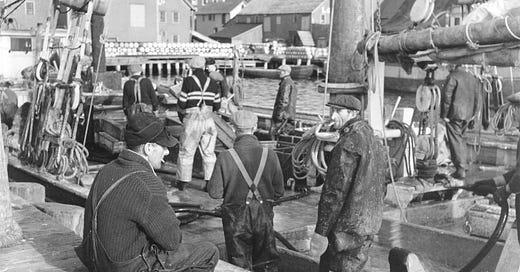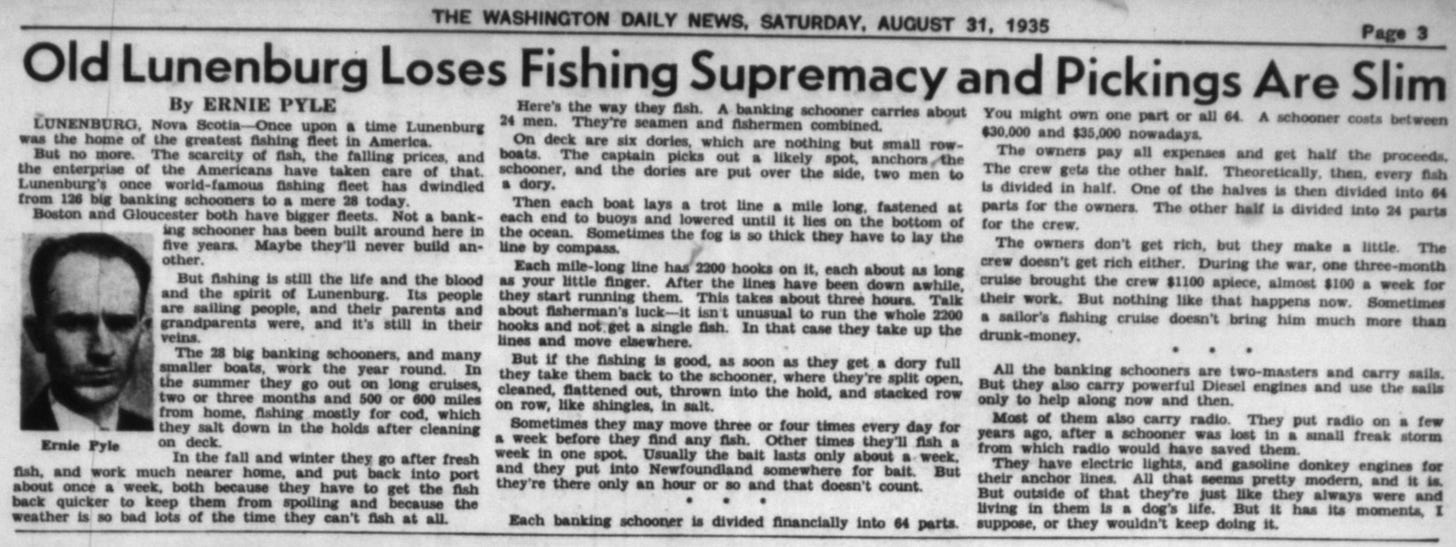The Washington Daily News—Saturday—August 31,—1935
Old Lunenburg Loses Fishing Supremacy and Pickings Are Slim
Ernie Pyle
LUNENBURG, Nova Scotia—Once upon a time Lunenburg was the home of the greatest fishing fleet in America.
But no more. The scarcity of fish, the falling prices, and the enterprise of the Americans have taken care of that. Lunenburg’s once world-famous fishing fleet has dwindled from 126 big banking schooners to a mere 28 today.
Boston and Gloucester both have bigger fleets. Not a banking schooner has been built around here in five years. Maybe they’ll never build another.
But fishing is still the life and the blood and the spirit of Lunenburg. Its people are sailing people, and their parents and grandparents were, and it’s still in their veins.
The 28 big banking schooners, and many smaller boats, work the year round. In the summer they go on long cruises, two or three months and 500 or 600 miles from home, fishing mostly for cod, which they salt down in the hold after cleaning on deck.
In the fall and winter they go after fresh fish, and work much nearer home, and put back about once a week, both because they have to get the fish back quicker to keep them from spoiling and because the weather is so bad lots of the time they can’t fish at all.
Here’s the way they fish. A banking schooner carries about 24 men. They’re seamen and fishermen combined.
On deck are six dories, which are nothing but small rowboats. The captain picks out a likely spot, anchors the schooner, and the dories are put over the side, two men to a dory.
Then each boat lays a trot line a mile long, fastened at each end to buoys and lowered until it lies on the bottom of the ocean. Sometimes the fog is so thick they have to lay the line by compass.
Each mile-long line has 2200 hooks on it, each about as long as your little finger. After the lines have been down awhile, they start running them. This takes about three hours. Talk about fisherman’s luck—it isn’t unusual to run the whole 2200 hooks and not get a single fish. In that case they take up the lines and move elsewhere.
But if the fishing is good, as soon as they get a dory full they take them back to the schooner, where they’re split open, cleaned, flattened out, thrown on row on row, like shingles, in salt.
Sometimes they may move three or four times every day for a week before they find any fish. Other times they’ll fish a week in one spot. Usually the bait lasts only about a week, and they put into Newfoundland somewhere for bait. But they’re there only an hour or so, and that doesn’t count.
● ● ●
Each banking schooner is divided financially into 64 parts. You might own one part or all 64. A schooner costs between $30,000 and $35,000 nowadays.
The owners pay all expenses and get half the proceeds. The crew gets the other half. Theoretically, then, every fish is divided in half. One of the halves is then divided into 64 parts for the owners. The other half is divided into 24 parts for the crew.
The owners don’t get rich, but they make a little. The crew doesn’t get rich either. During the war, one three-month cruise brought the crew $1100 apiece, almost $100 a week for the fisherman. But nothing like that happens now. Sometimes a sailor’s fishing cruise doesn’t bring him much more than drunk-money.
● ● ●
All the banking schooners are two-masters and carry sails. They carry powerful Diesel engines and use the sails only to help along now and then.
Most of them also carry radio. They put radio on a few years ago, after a schooner was lost in a small freak storm where the radio would have saved them.
They have electric lights and gasoline donkey engines for their anchor windlass. All that seems pretty modern, and it is. But outside of that they’re just like they always were, and living in them is a dog’s life. But it has its moments, I suppose, or they wouldn’t keep doing it.
💛 **Enjoyed this post?** Your support helps us continue to transcribe and promote Ernie’s work. Please click the link below to donate.





